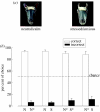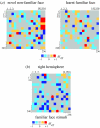Behavioural and neurophysiological evidence for face identity and face emotion processing in animals
- PMID: 17118930
- PMCID: PMC1764842
- DOI: 10.1098/rstb.2006.1937
Behavioural and neurophysiological evidence for face identity and face emotion processing in animals
Abstract
Visual cues from faces provide important social information relating to individual identity, sexual attraction and emotional state. Behavioural and neurophysiological studies on both monkeys and sheep have shown that specialized skills and neural systems for processing these complex cues to guide behaviour have evolved in a number of mammals and are not present exclusively in humans. Indeed, there are remarkable similarities in the ways that faces are processed by the brain in humans and other mammalian species. While human studies with brain imaging and gross neurophysiological recording approaches have revealed global aspects of the face-processing network, they cannot investigate how information is encoded by specific neural networks. Single neuron electrophysiological recording approaches in both monkeys and sheep have, however, provided some insights into the neural encoding principles involved and, particularly, the presence of a remarkable degree of high-level encoding even at the level of a specific face. Recent developments that allow simultaneous recordings to be made from many hundreds of individual neurons are also beginning to reveal evidence for global aspects of a population-based code. This review will summarize what we have learned so far from these animal-based studies about the way the mammalian brain processes the faces and the emotions they can communicate, as well as associated capacities such as how identity and emotion cues are dissociated and how face imagery might be generated. It will also try to highlight what questions and advances in knowledge still challenge us in order to provide a complete understanding of just how brain networks perform this complex and important social recognition task.
Figures







Similar articles
-
Distributed and interactive brain mechanisms during emotion face perception: evidence from functional neuroimaging.Neuropsychologia. 2007 Jan 7;45(1):174-94. doi: 10.1016/j.neuropsychologia.2006.06.003. Epub 2006 Jul 18. Neuropsychologia. 2007. PMID: 16854439 Review.
-
Social anhedonia is associated with neural abnormalities during face emotion processing.Neuroimage. 2011 Oct 1;58(3):935-45. doi: 10.1016/j.neuroimage.2011.06.059. Epub 2011 Jun 30. Neuroimage. 2011. PMID: 21763435
-
Neurobiological correlates of visual and olfactory recognition in sheep.Behav Processes. 1994 Dec;33(1-2):89-111. doi: 10.1016/0376-6357(94)90061-2. Epub 2002 May 31. Behav Processes. 1994. PMID: 24925241
-
The activation of visual memory for facial identity is task-dependent: evidence from human electrophysiology.Cortex. 2014 May;54:124-34. doi: 10.1016/j.cortex.2014.02.008. Epub 2014 Feb 24. Cortex. 2014. PMID: 24657481
-
The many faces of research on face perception.Philos Trans R Soc Lond B Biol Sci. 2011 Jun 12;366(1571):1634-7. doi: 10.1098/rstb.2010.0386. Philos Trans R Soc Lond B Biol Sci. 2011. PMID: 21536550 Free PMC article. Review.
Cited by
-
Discrimination of human faces by archerfish (Toxotes chatareus).Sci Rep. 2016 Jun 7;6:27523. doi: 10.1038/srep27523. Sci Rep. 2016. PMID: 27272551 Free PMC article.
-
Beyond element-wise interactions: identifying complex interactions in biological processes.PLoS One. 2009 Sep 23;4(9):e6899. doi: 10.1371/journal.pone.0006899. PLoS One. 2009. PMID: 19774090 Free PMC article.
-
Goats prefer positive human emotional facial expressions.R Soc Open Sci. 2018 Aug 29;5(8):180491. doi: 10.1098/rsos.180491. eCollection 2018 Aug. R Soc Open Sci. 2018. PMID: 30225038 Free PMC article.
-
Social recognition is context dependent in single male prairie voles.Anim Behav. 2013 Nov;86(5):10.1016/j.anbehav.2013.09.015. doi: 10.1016/j.anbehav.2013.09.015. Anim Behav. 2013. PMID: 24273328 Free PMC article.
-
Matters of development and experience: Evaluation of dog and human emotional expressions by children and adults.PLoS One. 2023 Jul 26;18(7):e0288137. doi: 10.1371/journal.pone.0288137. eCollection 2023. PLoS One. 2023. PMID: 37494304 Free PMC article.
References
-
- Aggleton J.P, Young A.W. The enigma of the amygdala: on its contribution to human emotion. In: Lane R.D, Nadel L, editors. Cognitive neuroscience of emotion. Oxford University Press; New York, NY: 2000. pp. 106–128.
-
- Baker C.I, Keysers C, Jellema T, Wicker B, Perrett D.I. Neuronal representation of disappearing and hidden objects in temporal cortex of the macaque. Exp. Brain. Res. 2001;140:375–381. doi:10.1007/s002210100828 - DOI - PubMed
-
- Bauer H.R, Philip M. Facial and vocal individual recognition in the common chimpanzee. Psychol. Rec. 1983;33:161–170.
-
- Baylis G.C, Rolls E.T, Leonard C.M. Selectivity between faces in the responses of a population of neurons in the cortex in the superior temporal sulcus of the monkey. Brain. Res. 1985;342:91–102. doi:10.1016/0006-8993(85)91356-3 - DOI - PubMed
-
- Bekoff M. Animal reflections. Nature. 2002;419:255. doi:10.1038/419255a - DOI - PubMed
Publication types
MeSH terms
LinkOut - more resources
Full Text Sources

